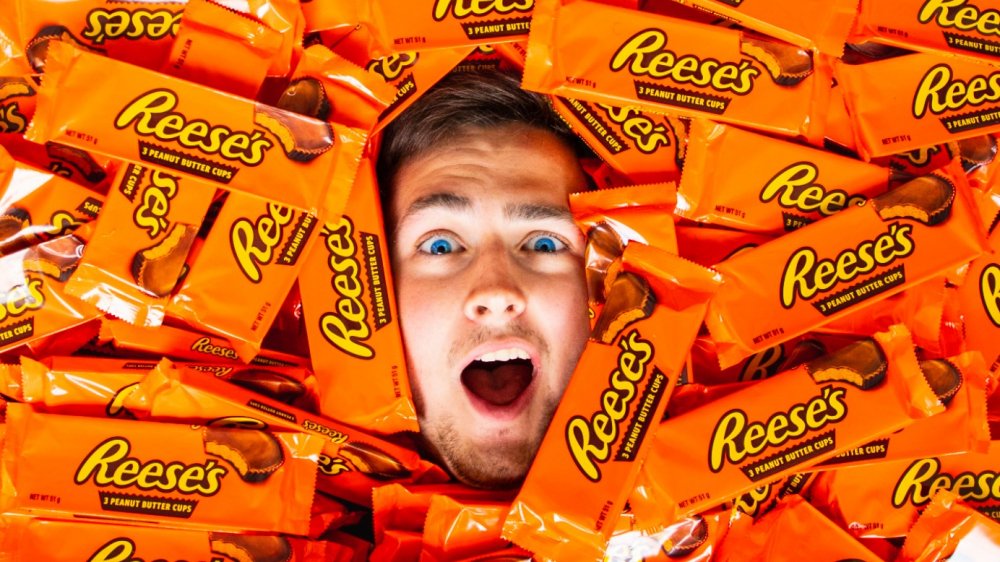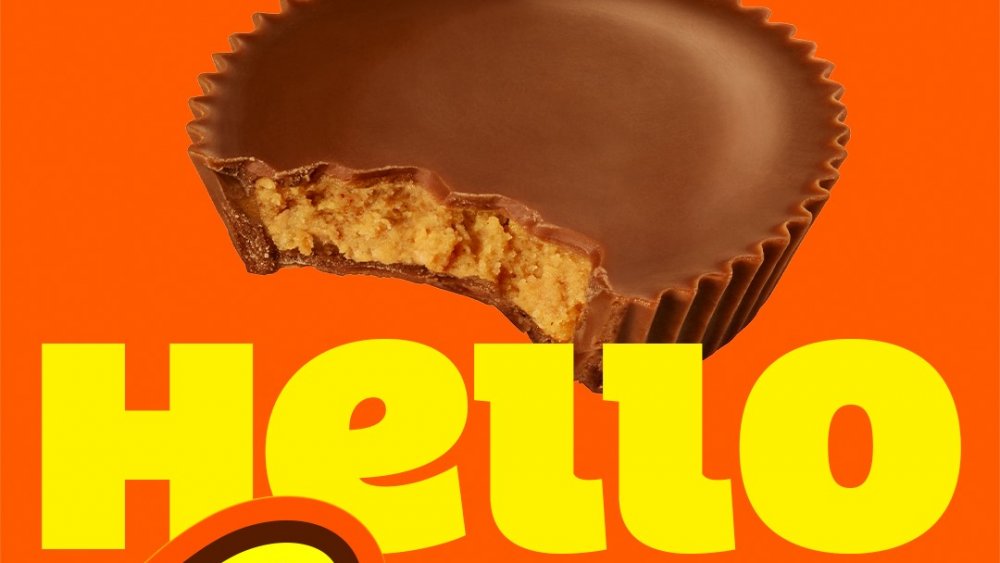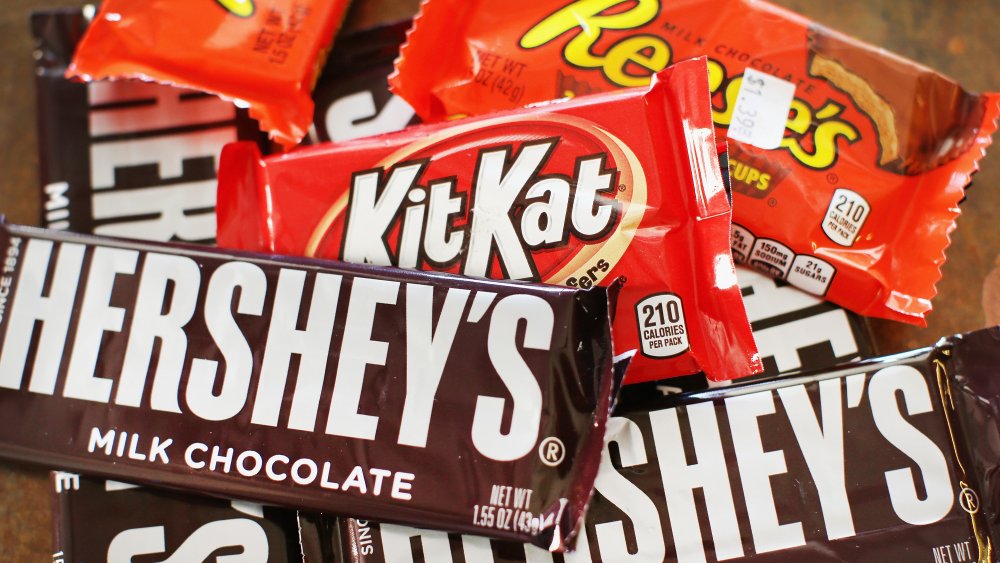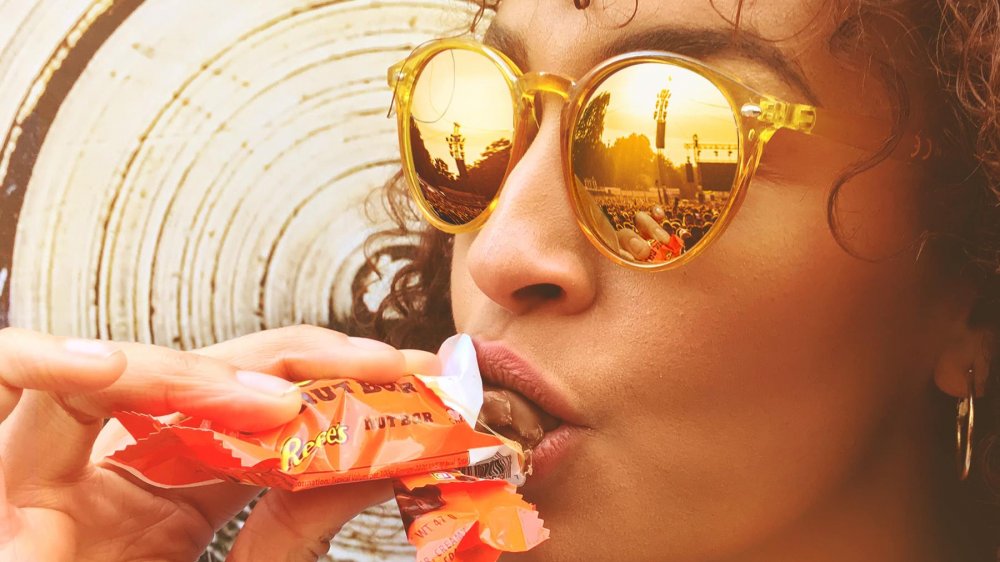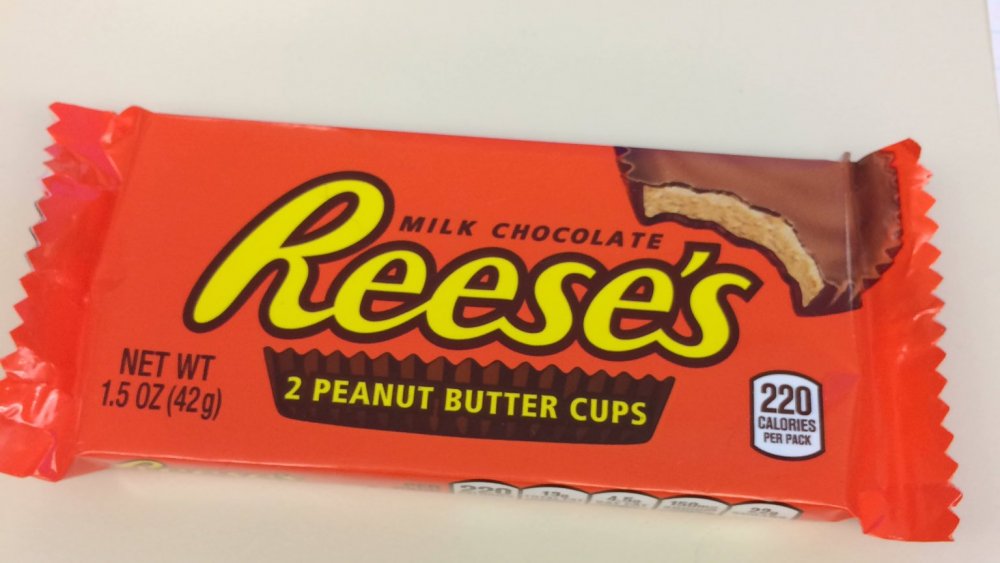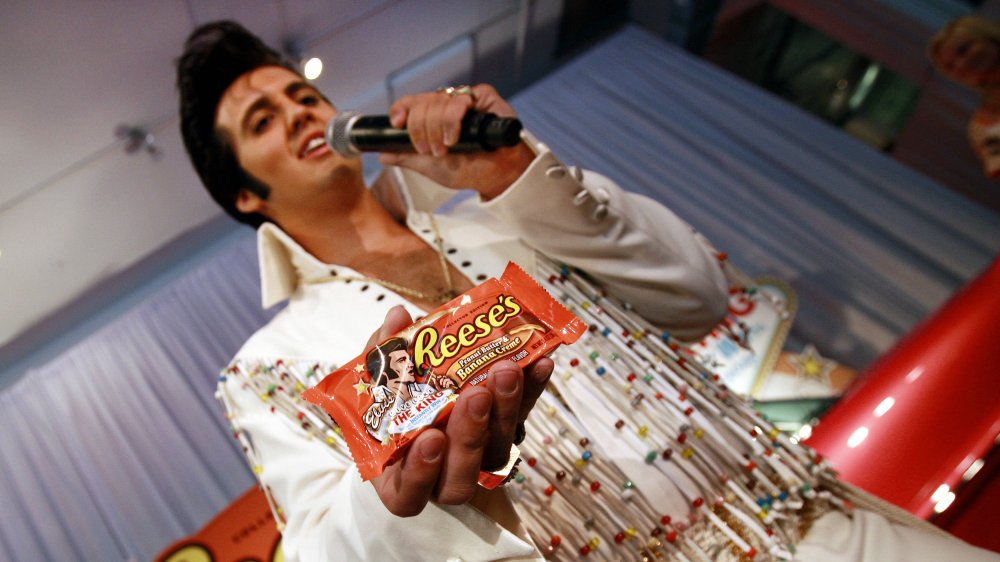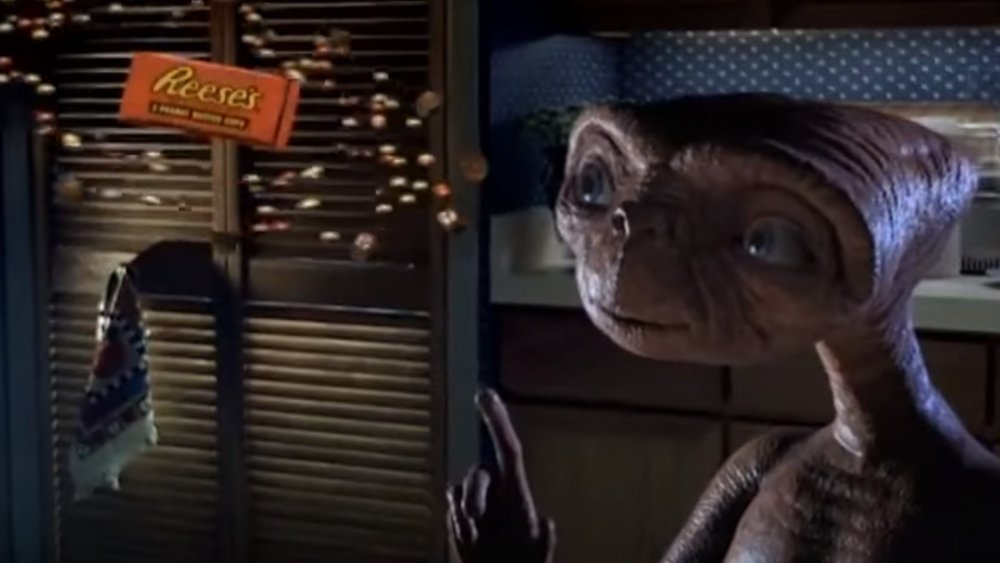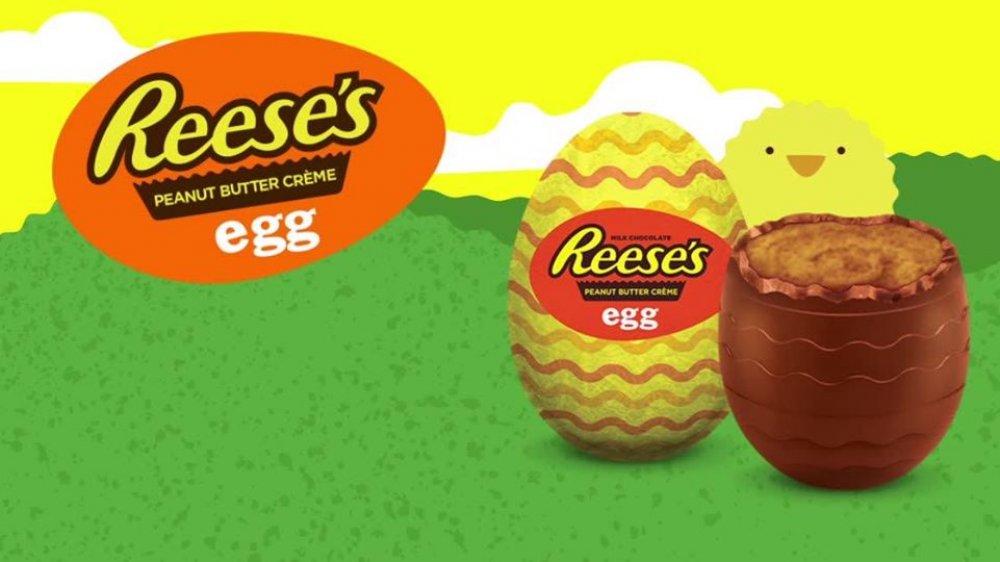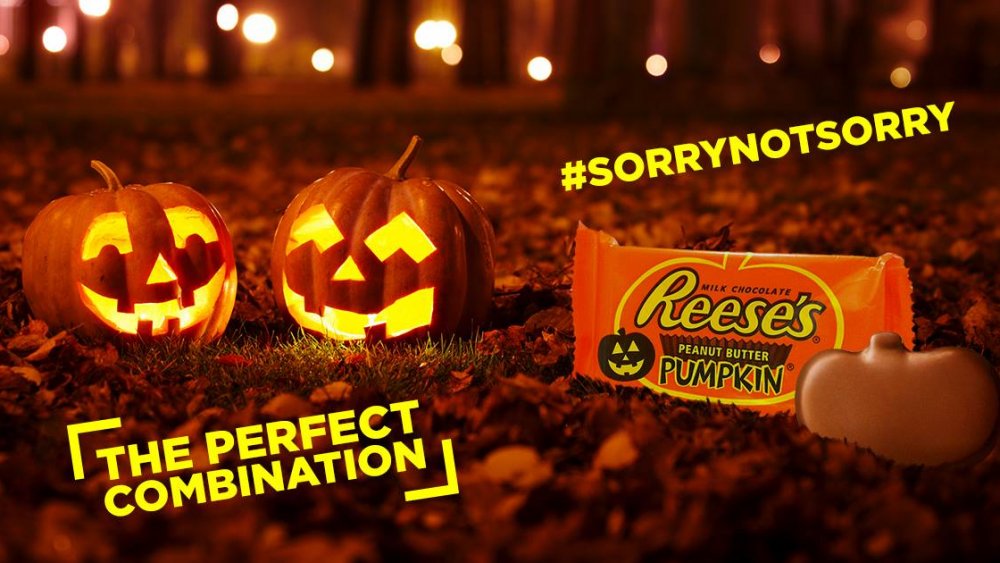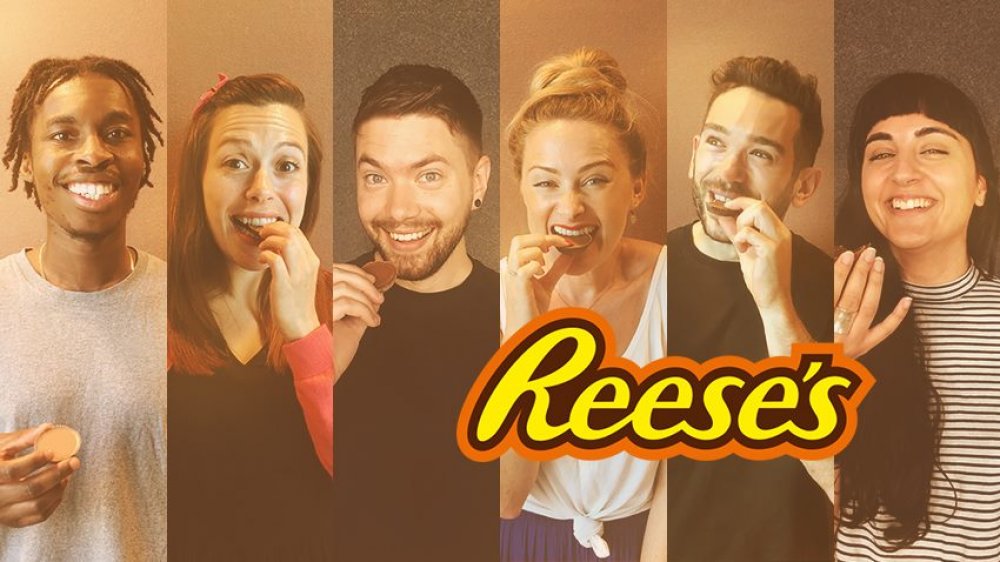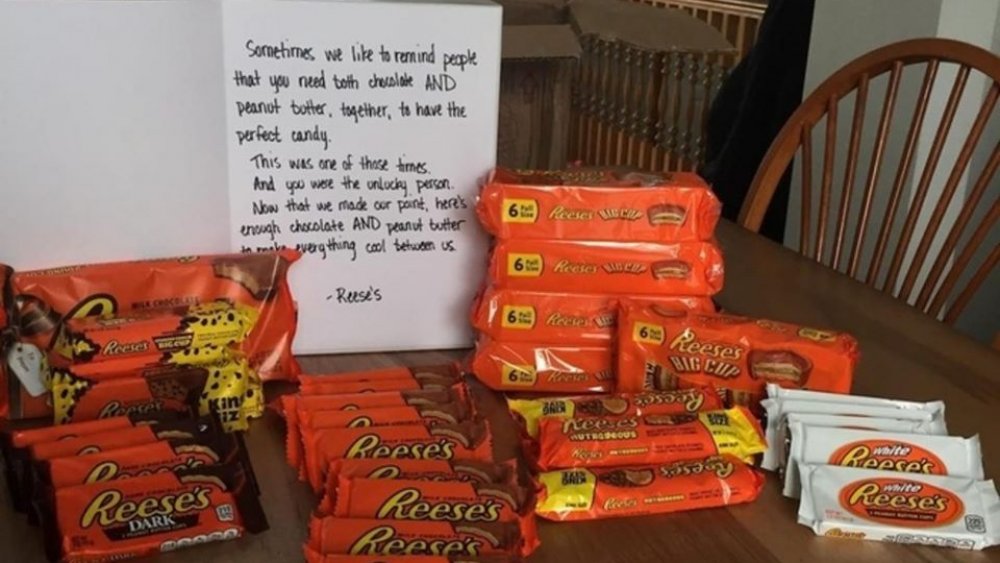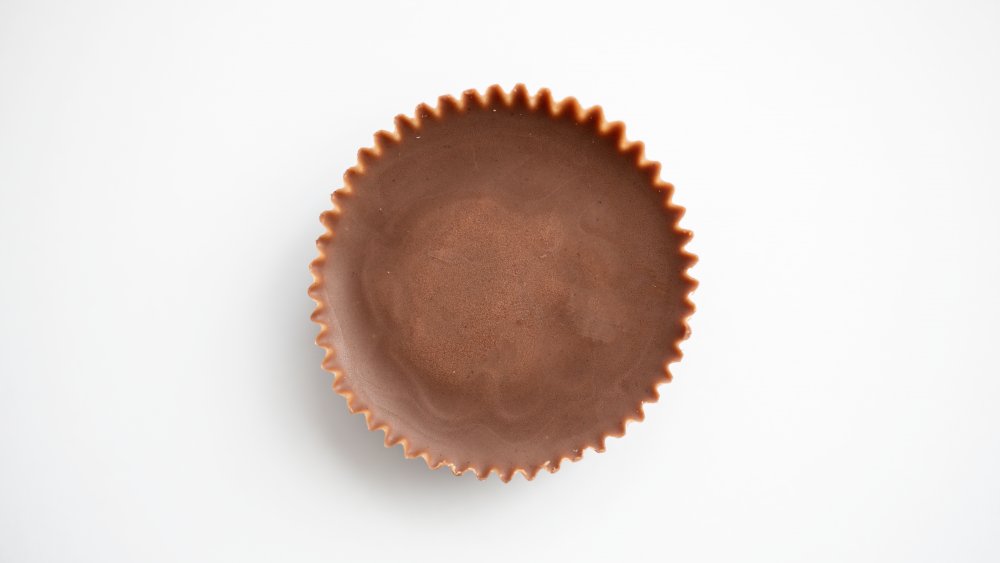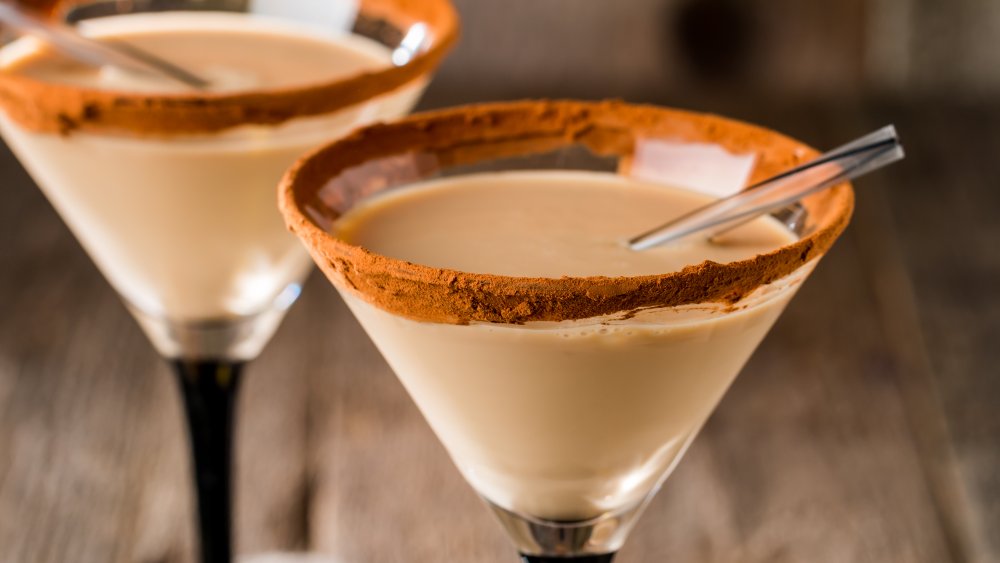The Untold Truth Of Reese's
Seriously, is there anything better than the heavenly mix of chocolate and peanut butter? There's something about Reese's that's just right. It doesn't matter if you're craving something sweet or something salty, Reese's has you covered.
If Reese's are your go-to candy, you're definitely not alone. According to YouGov, the Reese's Peanut Butter Cup is the third most popular candy in the US (passed only by M&Ms and Hershey's), and of all those surveyed, an overwhelming 81 percent liked them. (Only 6 percent didn't, and who are those people?) The data is interesting: for the most part, people can agree that Reese's are delicious, regardless of what generation they belong to. Now you know — when someone wonders what millennials and boomers have in common, the answer is, "A love of Reese's."
There's something incredibly wholesome about that, isn't there? It's more than a sweet fix, it's the candy that brings the generations together. Now, in the spirit of togetherness, let's talk about some fun facts that even the biggest Reese's fans might not know.
Reese's had very unlikely beginnings
While you might expect the culinary genius behind Reese's to be a lifelong candy-maker, that's not the case at all. The "Reese" that the candy was named for is creator Harry Burnett Reese, and according to the Hershey Archives, he labored away at a long list of jobs before he even came up with the idea of making candy. He was a factory worker, a farmer, and he even managed a fish hatchery, all before becoming a dairy farmer employed by none other than Milton Hershey.
Even then, the road to success wasn't a straight one. Reese found himself needing to make some extra cash to support his growing family, and in 1919, he met a man at a Harrisburg, Pennsylvania market who gave him a recipe and asked him to make hard candies. It didn't work — the candies stuck together — so it was back to the drawing board. Reese tried making a candy bar named for his daughter, a coconut caramel bar, and finally, he started making candies with various centers covered in chocolate. Originally, the chocolates came in assorted boxes: centers were cherry, dates, coconut, and, of course, peanuts. Starting to sound familiar? It absolutely should, because it was the foundation of a great idea.
Reese and Hershey were a match made in heaven
According to Business Insider, Reese always used fresh ingredients for the centers of his candies, as well as Hershey's chocolate. He had started on one of Hershey's dairy farms in 1917 before he eventually made the jump to working in the chocolate factory.
According to Atlas Obscura, Reese was still working for Hershey when he decided to strike out on his own. He quit his job in 1923, but first, he went to Hershey and asked for his permission not just to quit, but to set up his own candy company. Hershey said yes under the stipulation that all of Reese's chocolate had to come from the Hershey company. He agreed, and five years later, a simple suggestion would change the course of the company. A shop owner Reese was visiting on a sales call asked him if he could make something that was peanut butter on the inside and chocolate on the outside. Fortunately, he said he could, and it would go on to become the company's flagship product.
Decades later, and Hershey purchased Reese's in 1963, seven years after Reese died of a heart attack. It wasn't entirely surprising, as Milton Hershey always had some peanut butter cups in his desk, and when they were buried in Hershey cemetery, the longtime friends and collaborators were laid to rest just meters apart.
At one time, Reese's were impossible to make in the summer
It's easy to forget that luxuries like air-conditioning and climate control haven't been around forever — and when you're working with chocolate, heat can cause some serious problems.
For Reese, it absolutely did.
Throughout the 1930s, his company was faced with a huge problem: In the summer months, it was just too hot to make chocolate candies. Everything would simply melt, and this was well before there was a quick and affordable solution. Chocolate was off the table — quite literally. But, if they wanted to keep the company afloat, they still needed to keep employees busy and pay the bills. To find a solution, the candy entrepreneur turned to a completely different industry to keep the lights on — canning. According to the Hershey Archives, employees would can beans and tomatoes when they couldn't make chocolate. They did everything by hand, from prepping the vegetables to putting the labels on the cans. Who would have thought that without tomatoes, there would probably be no Reese's?
Here's why Reese's only makes peanut butter cups
Reese's started out making all sorts of candy, so why do we only get peanut butter cups today? According to Atlas Obscura, part of the reason is just that they were an outstanding success. Family lore says that when Reese was first trying to figure out how to make his peanut butter cups, he roasted his peanuts to the point where they were on the verge of burning — and that's what still gives Reese's peanut butter that oh-so-distinctive, unmistakable taste. Times were tough but sales were strong, and he was able to weather the lean years of the Great Depression.
But then came World War II and with it, food rationing. Sugar was on the top of the list of ingredients that were suddenly in limited supply, and even though Hershey shared some of his stock with Reese, it wasn't enough for him to keep up with demand. Some of his candies simply had to go and in the end, he kept only the peanut butter cup.
It was a practical decision that ended up being a very good one since his peanut butter cups required the least amount of sugar to make.
Reese's had an unusual ad campaign strategy
Ad campaigns can make or break a product, and in the case of Reese's, their biggest ad campaigns definitely helped raise their profile. While you might think a well-established brand would want to market their longevity, Reese's did the opposite. They launched a major 1970s campaign by pretending the candy was something new and that most people didn't even like the idea of chocolate and peanut butter together.
How it all came together was a little strange. Atlas Obscura says chocolate-covered peanut butter candies had been sold as early as 1907 and when Hershey bought Reese's in 1963, the peanut butter cups were a huge hit. In fact, by 1969, they were Hershey's best-selling candy. However, when they kicked off their very first national ad campaign, they marketed Reese's like a brand new idea that might seem gross, but was actually delicious.
The premise was simple: ads showed two people, one eating chocolate and one eating peanut butter. The people would collide and say, "Hey, you got peanut butter on my chocolate!" and "Hey, you got chocolate on my peanut butter!" They would then suddenly realize the amazing combo.
Why act like it's something new they have to convince people to try? Hershey wanted to firmly cement the relationship between Reese's and Hershey in the public's mind. Rebranding made people associate the candy with something the Hershey company had created, and thus, they got all the credit.
Reese's Pieces stuck around because of E.T.
In the 1970s, Hershey launched a new product that they originally called PBs. These candy-coated peanut butter bits were eventually renamed Reese's Pieces, and you'd think that the name "Reese's" would have been enough to make them a major hit.
At first, they kind of were. The candies had a successful launch, but according to the Hershey Archives, it wasn't long before sales started tapering off. That's not something any company wants to see, so when they got a phone call from Universal Studios, it was a big deal.
The phone call was about a movie called E.T., and Universal wanted to let Hershey know that Reese's Pieces were going to be in the movie. Not surprisingly, the candy company jumped at the chance to help promote the movie. Hershey took a gamble and agreed to give Universal around a million dollars worth of marketing for E.T. without even seeing a script. Remember, in hindsight, we know what a huge hit the movie was, but at the time, Hershey was essentially taking a chance with a hefty wad of cash.
It paid off. Sales of Reese's Pieces skyrocketed, and according to Snopes, it only happened because someone else had said "No," first — and that was M&Ms.
Some Reese's have a lot more peanut butter than others
Sure, the chocolate is great and all, but it's Reese's unique peanut butter that makes them amazing. If you're in Camp Peanut Butter, you should know that not all Reese's are created equal — and fortunately, someone's done the math so you know just what you should splurge on.
Redditor Rustid (via the Huffington Post) took a handful of various Reese's candy, scraped out the peanut butter, and weighed it to come up with a definitive chocolate-to-peanut butter ratio rating. The findings are pretty surprising, and include the fact that the Small Heart contains the least amount of peanut butter — just around 19 percent! Yikes!
On the flip side, there's the egg and the heart, which have a much more generous amount of about 60 percent peanut butter. The pumpkin and the King Size come in just below that with a touch over 50 percent peanut butter. That means all you peanut butter lovers out there should probably keep in it in mind that Valentine's Day and Easter are the time to stock your year's stash.
What about those that are on the bottom? Minis come in pretty low on the ratio, too, as they're around 28 percent peanut butter. Now you know, and you can plan accordingly.
The brilliance of the Reese's candy converter
Halloween is a great time of year, but it always comes with a certain amount of disappointment. There's always candy left in the bag that literally no one on the block actually wants, and in 2018, Reese's came up with a pretty awesome way to demonstrate their superiority.
According to CNN, Reese's took the street of New York City with a giant orange machine. The idea was simple: drop in your unwanted Halloween candy, and get peanut butter cups in return. Win, right? The machine was ready, willing, and able to give out around 10,000 peanut butter cups in just the five hours it was out on the street, and it was a massive hit. Sadly, it seems as though that was its only appearance. Hershey spokespeople hinted that they might "bring the Reese's Candy Exchange to other cities" in the following years. Maybe if we all asked nicely the candy converting machine will go on a national tour?
Let's debunk that viral post on why you shouldn't eat them
Some people want nothing more than to ruin good things for others, and one particular viral post that's made the rounds on social media is the perfect example of that. It supposedly contains information on why you shouldn't eat Reese's, and it focuses on three ingredients: soy lecithin, PGPR, and TBHQ. The post links the ingredients to all kinds of nasty things like cancer, gastrointestinal problems, and "delirium and collapse." Snopes took a look at what the truth is.
The three ingredients are in Reese's, but that's about all there is to the truth of it. The claim that soy lecithin causes cancer comes from a single 1985 study where rats were exposed to around 1000 times more soy lecithin than a human gets in a day and yes, of course, there were problems... but not for the quantity that's in a Reese's. That's kind of like saying apples are bad for you because their seeds contain cyanide. (They do, says Medical News Today, but that's not keeping you away from apples, is it?)
PGPR, which is used to improve texture, has been repeatedly proven safe by the European Food Safety Authority, and as for TBHQ, that's a preservative that has also been repeatedly tested and approved by numerous food safety authorities. There are no studies out there, however, that support the claims made in the viral post. So go ahead — grab those Reese's.
If you get a bad Reese's, they'll replace it
No one's perfect, and sometimes, things slip through the cracks. That's even happened with Reese's, and there's a valuable lesson to be learned here — if you get a Reese's without the peanut butter, definitely reach out to them on social media.
In 2018, an Iowa man named Alex Hentges headed over to their Facebook page to post about his peanut-butter-less Reese's and ask the company what the heck was going on. They responded, and Today says that at first, they told him they were going to be sending him some coupons to replace his defective Reese's. When mail showed up a few days later, it was something much more substantial. Hentges received a letter of apology and a massive box containing about 5 pounds of various Reese's candy. Win!
While they said that they weren't sure just how that particular cup missed getting its peanut butter, they said: "...The brand had to make things right!" Now that's just great customer service.
There's a scientific reason Reese's taste so good
Reese's mix of chocolate and peanut butter is nothing short of magical, and it turns out that there's a scientific principle at work here.
According to Penn State University professor of food science Gregory Ziegler (via Mic), it's something called "dynamic sensory contrast." What's going on here is that your taste buds essentially love it when you eat something with completely contrasting textures — like the smoothness of the chocolate and the slightly crunchy peanut butter.
Couple that with another contrasting combination — the sweetness of the chocolate and the saltiness of the peanut butter — and you've got a winning team that no one can resist. There's a catch, though — these contrasting flavors and textures are so good that it makes you sort of forget how much you're eating. Ever powered your way through half a bag of Minis without realizing it? It wasn't you just being a glutton, it was science! Essentially, these contrasting flavors can taste so good it overrides our sense of feeling full. The principle is also called the "ice cream effect," and it's why there's just always room for ice cream even after the biggest of dinners.
If you've never used Reese's in a cocktail, you're missing out
Sure, we've all had Reese's on their own, and you've probably even baked with them, too. But have you had them in a cocktail? No? Why not!
First, grab a bottle of vodka and a handful of Reese's Pieces. Take out just enough vodka that you can pour in those little candy nuggets of deliciousness, replace the top, and let it sit. It might have to hang out on the top shelf for a few days, but it's worth the wait. The vodka will be infused with all that Reese's flavor and when it's done, it's cocktail time!
It's the perfect thing to add to a dessert cocktail. Mix with milk, chocolate liqueur, and add a dash of chocolate syrup. Sounds pretty brilliant, right? Pretty much any drink that features those ingredients — or some cream, chocolate vodka, or Irish cream — is made better with the addition of some Reese's-infused vodka. Better still? Use it to mix up a boozy milkshake, and it'll be your new go-to treat.
